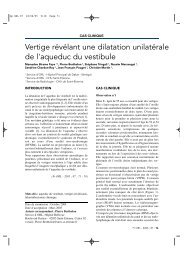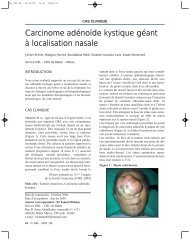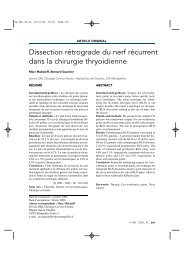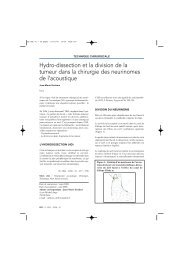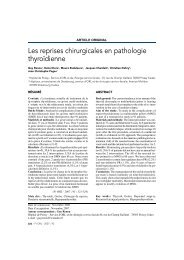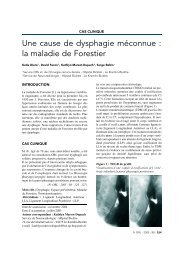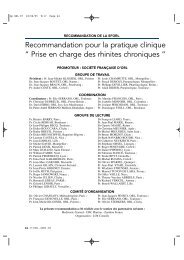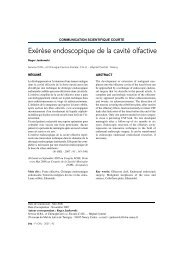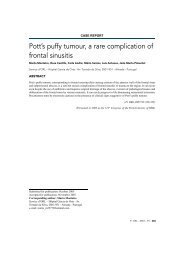Indications et techniques de l'imagerie de l'oreille et du rocher
Indications et techniques de l'imagerie de l'oreille et du rocher
Indications et techniques de l'imagerie de l'oreille et du rocher
You also want an ePaper? Increase the reach of your titles
YUMPU automatically turns print PDFs into web optimized ePapers that Google loves.
magerie indiquée<br />
e façon sélective<br />
<strong>et</strong>/ou IRM en fonction<br />
données cliniques <strong>et</strong><br />
paracliniques<br />
+/- TDM en fonction<br />
données cliniques <strong>et</strong><br />
paracliniques<br />
M +/- TDM en fonction<br />
données cliniques <strong>et</strong><br />
paracliniques<br />
RM en fonction <strong>de</strong>s<br />
nées cliniques <strong>et</strong> TDM<br />
Imagerie indiquée<br />
<strong>de</strong> façon sélective<br />
RM en fonction <strong>de</strong> l’âge<br />
t <strong>du</strong> contexte (gra<strong>de</strong> C)<br />
TDM en cas <strong>de</strong><br />
dysfonctionnement <strong>de</strong><br />
l’implant (gra<strong>de</strong> B)<br />
ORL 94 27/06/08 12:50 Page 364<br />
Recommandation pour la pratique clinique : Imagerie <strong>de</strong> l’oreille <strong>et</strong> <strong>du</strong> <strong>rocher</strong><br />
B.1.2 Sténose <strong>du</strong> meat acoustique externe <strong>et</strong> lateralisation<br />
<strong>de</strong> la membrane tympanique<br />
Situation clinique Imagerie systématique Imagerie indiquée<br />
<strong>de</strong> façon sélective<br />
Sténose osseuse TDM<br />
Sténose fibreuse <strong>et</strong><br />
latéralisation <strong>de</strong> la TDM<br />
membrane tympanique<br />
B.1.3 Surdité <strong>de</strong> transmission <strong>et</strong> mixte à tympan<br />
normal<br />
Situation clinique Imagerie systématique Imagerie indiquée<br />
<strong>de</strong> façon sélective<br />
ST <strong>de</strong> l’a<strong>du</strong>lte<br />
Échec fonctionnel<br />
TDM en préopératoire TDM en fonction<br />
<strong>du</strong> tableau clinique<br />
après chirurgie<br />
stapédovestibulaire<br />
TDM<br />
Échec fonctionnel TDM en fonction<br />
après ossiculoplastie <strong>du</strong> tableau clinique<br />
ST <strong>de</strong> l’enfant TDM (gra<strong>de</strong> B)<br />
ST : surdité <strong>de</strong> transmission<br />
B.1.4 Surdité <strong>de</strong> transmission <strong>et</strong> mixte à tympan<br />
pathologique<br />
Situation clinique Imagerie Imagerie indiquée<br />
systématique <strong>de</strong> façon sélective<br />
Otite séromuqueuse Exceptionnellement indiquée<br />
enfant (forme atypique ou suspicion<br />
<strong>de</strong> pathologie sous-jacente)<br />
TDM ± IRM (accord professionnel)<br />
Otite séromuqueuse Fréquemment indiquée<br />
a<strong>du</strong>lte (surtout formes unilatérales<br />
ou traînantes)<br />
TDM ± IRM (accord professionnel)<br />
Otite chronique non Rarement indiquée<br />
dangereuse (éventuellement pour déterminer<br />
l’origine d’une hypoacousie <strong>de</strong><br />
transmission ou mixte > 30-40 dB,<br />
non expliquée par l’examen<br />
otoscopique ou l’histoire clinique)<br />
TDM (gra<strong>de</strong> B)<br />
Otite atélectasique <strong>et</strong> TDM indiquée (gra<strong>de</strong> B)<br />
poche <strong>de</strong> rétraction - si critères <strong>de</strong> gravité (poche<br />
<strong>de</strong> rétraction non contrôlable,<br />
<strong>et</strong>/ou otorrhéïque,<br />
<strong>et</strong>/ou <strong>de</strong>squamante ou rétentive,<br />
<strong>et</strong>/ou évolutive lors d’examens<br />
otoscopiques successifs)<br />
- si surdité <strong>de</strong> transmission<br />
non expliquée par l’examen<br />
otoscopique ou l’histoire clinique<br />
Cholestéatome TDM (gra<strong>de</strong> B) IRM : parfois en complément<br />
(évaluation initiale) <strong>de</strong> la TDM, pour préciser<br />
certaines complications<br />
(accord professionnel)<br />
Cholestéatome Le plus souvent<br />
(surveillance recommandée après<br />
postopératoire) tympanoplastie<br />
en technique fermée<br />
TDM (± IRM) (gra<strong>de</strong> B)<br />
B.2 Vertiges <strong>et</strong> troubles <strong>de</strong> l’équilibre<br />
Situation clinique Imagerie Imagerie indiquée<br />
systématique <strong>de</strong> façon sélective<br />
Vertige positionnel IRM (gra<strong>de</strong> C)<br />
atypique<br />
Suspicion d’acci<strong>de</strong>nt IRM (gra<strong>de</strong> B)<br />
vasculaire aigu<br />
Suspicion clinique <strong>de</strong> IRM (gra<strong>de</strong> B)<br />
pathologie neurologique<br />
Syndrome vestibulaire IRM (gra<strong>de</strong> C)<br />
déficitaire persistant<br />
Surdité associée IRM (gra<strong>de</strong> B)<br />
Anomalies constatées lors IRM (gra<strong>de</strong> C)<br />
<strong>de</strong>s explorations otoneurologiques<br />
Vertige <strong>de</strong> l’enfant IRM ou TDM (gra<strong>de</strong> B)<br />
B.3 Acouphenes<br />
Situation clinique Imagerie systématique Imagerie indiquée<br />
<strong>de</strong> façon sélective<br />
Acouphène subjectif IRM avec séquence<br />
à tympan normal angiographique si<br />
signes associés (gra<strong>de</strong> C)<br />
Acouphène objectif à IRM avec séquence<br />
tympan normal angiographique (gra<strong>de</strong> C)<br />
Acouphène à tympan TDM (gra<strong>de</strong> C) IRM avec séquence<br />
pathologique angiographique (gra<strong>de</strong> C)<br />
Paragangliome TDM avec séquence IRM avec séquence<br />
angiographique (gra<strong>de</strong> C) angiographique (gra<strong>de</strong> C)<br />
B.4 Otalgies<br />
B.5 Paralysies faciales<br />
Situation clinique Imagerie Imagerie indiquée<br />
systématique <strong>de</strong> façon sélective<br />
Otite moyenne TDM si évolution défavorable<br />
aiguë (gra<strong>de</strong> C)<br />
Mastoïdite aiguë TDM injecté (gra<strong>de</strong> C) IRM si suspicion <strong>de</strong><br />
complication intracrânienne<br />
(gra<strong>de</strong> C)<br />
Otite externe<br />
nécrosante<br />
TDM + IRM scintigraphie couplée Te99 <strong>et</strong> Ga 67<br />
Ga 67 pour surveillance<br />
évolutive <strong>et</strong> arrêt <strong>du</strong> TTT<br />
Traumatisme <strong>du</strong> <strong>rocher</strong> TDM (gra<strong>de</strong> A)<br />
Tumeurs TDM + IRM<br />
Paralysie faciale IRM si syndromique ou<br />
a frigore évolution péjorative<br />
Zona IRM si syndromique ou<br />
évolution péjorative<br />
Spasme <strong>de</strong> l’hémiface IRM<br />
Fr ORL - 2008 ; 94 : 364



